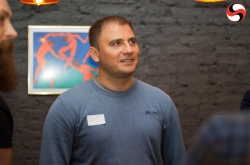‘The Unusual Laws of Refraction and Reflection’ narrates its story in the form of a lively dialog between the physicist father and his high-schooler son. The explanatory monologs are punctuated with to-the-point remarks and comparisons with physics theory from the school curricula. The narrator often draws analogies between the theory and the real-world phenomena such as circus and waves.
In total, Dr. Silin’s visionary book unpacks nine topics of contemporary physics, including phase and group wave velocity, isofrequencies, anisotropic substances, magnetostatic waves, unheard-of environments with energy spreading in every direction, reverse-traveling waves in positive-penetration environments, spatial dispersion and reverse-traveling waves, metamaterials with reverse-traveling waves and a short history of years of research on the unusual laws of refraction and reflection.
Adapted by the legendary author himself, the new reprint features sweeping changes of the chapters on reverse-traveling waves with a short summary on the history of their research, as well as some new additions in the form of media with spiral inclusions. ITMO University’s Faculty of Physics and Engineering staff took on the role of editors and scientific consultants.

“Robert Silin is a great Russian scientist and highly skilled specialist, and it is most unfortunate for science on the whole that his avant-garde ideas got lost in the Soviet Union era,” says Pavel Belov, Dean of the Faculty of Physics and Engineering. “Whereas he was one of the leading researchers of his time: it was he who penned the pioneering works on lens with negative refraction. Contemporary scientists are convinced that this discovery was made by Sir John Pendry in 2001, but in reality, Prof. Silin worked on it as far back as the 1970’s. His groundbreaking research is worthy of a Nobel Prize. His books on slow-wave circuits and periodic waveguides top the must-read list for every periodic systems scholar. They are so forward-thinking and useful that our scientists swear by them these last 30 years.”
After the perestroika period, English has become the lingua franca of Russian science, continues Pavel Belov. That left many iconic scientists out, Robert Silin among them.
“He never knew any English, never aspired to force his way through in the Academy of Sciences, but remained loyal to a closed-off military enterprise ‘Istok’. Regrettably, the scientific community has already started to forget him and rediscover that what was already done by this outstanding scientist. John Pendry himself met Dr. Silin at ‘Defraction Days’, a conference we hosted in 2011, and just couldn’t believe that the Soviet Union had such scientific greats as him.”
The Faculty of Physics and Engineering staff decided to bring Robert Silin’s monumental works back to the scientific mainstream. ‘Slow-Wave Circuits’ and ‘Periodic Waveguides’ have already been translated into English and are now waiting to be published by a foreign printing house. ‘The Unusual Laws of Refraction and Reflection’ is to be republished for modern-day school students interested in science.
To add to his impressive scientific record, Prof. Silin had started to research metamaterials long before other Soviet scientists who later became famous for their work in this field.

“It’s interesting that Victor Veselago’s 1967 article on the electrodynamics of substances with simultaneously negative values is now considered legendary and formative for this strand of science. Silin had started exploring this topic two years before Veselago, having been inspired by Leonid Mandelstam’s lectures. His meeting with Veselago didn’t take place until 2000. That often happens: an idea is suspended in air and several scientists start to pursue it simultaneously, without knowing about each other’s existence,” shares Yulia Kuznetsova, member of the Faculty of Physics and Engineering’s staff.
Robert Silin is an accomplished Professor and Doctor of Sciences. Becoming a physicist was his childhood dream.
“In fifth or sixth form, two guys came to our lesson. They were blasting odd words like ‘power converters! electronic arcs!’ We asked them what these words meant, and they gave us a no less mysterious explanation. So my friend and I went to the library, took a book called ‘Young electrician’, and started to look into what they were scaring us with in the class. We would even cut metal cans into sheets to make a small engine. Also, we had a great deputy head teacher who always encouraged us to make presentations on interesting topics, so I did a couple of those on physics. I liked it and soon started to read books by Yakov Perelman. That’s how I got into physics,” shared Robert Silin in an interview.

After graduating from the Moscow State University’s Faculty of Physics, he was assigned to work in the Ministry of Microelectronics Manufacturing and then to the research center of the military enterprise ‘Istok’, which was called ‘letterbox’ by its staff on the account of its highly secretive operations. That’s why Silin’s works never got mentioned in scientific journals.
During his time at ‘Istok’, Robert Silin did high-profile research in the field of slow-wave circuits and applied electrodynamics. He stayed at the enterprise for over 50 years, continuing his work as a professor emeritus there till the day he died. Prof. Silin has passed away on September 8, 2018, leaving a lifetime of outstanding research and an immense contribution to science.






